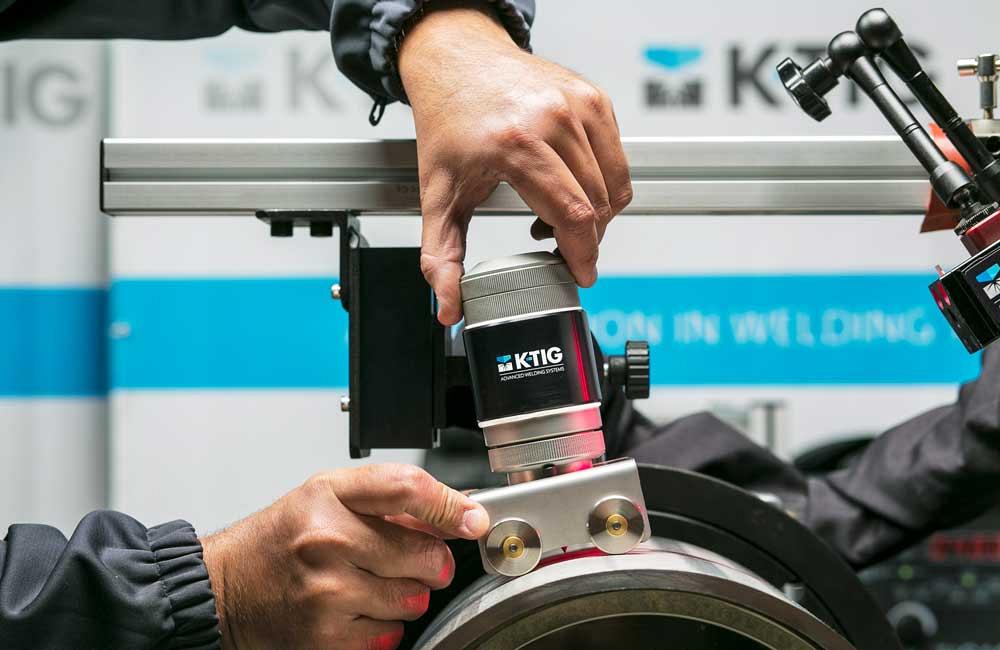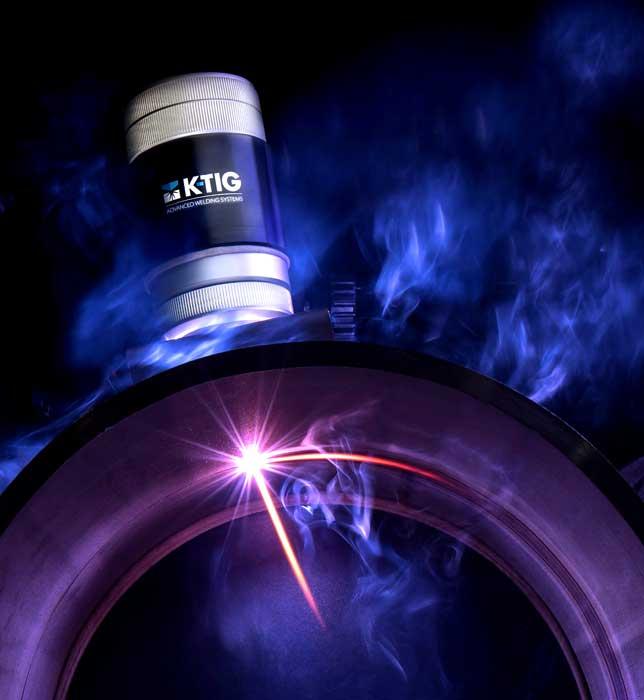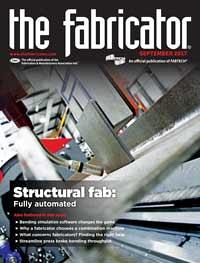Senior Editor
- FMA
- The Fabricator
- FABTECH
- Canadian Metalworking
Categories
- Additive Manufacturing
- Aluminum Welding
- Arc Welding
- Assembly and Joining
- Automation and Robotics
- Bending and Forming
- Consumables
- Cutting and Weld Prep
- Electric Vehicles
- En Español
- Finishing
- Hydroforming
- Laser Cutting
- Laser Welding
- Machining
- Manufacturing Software
- Materials Handling
- Metals/Materials
- Oxyfuel Cutting
- Plasma Cutting
- Power Tools
- Punching and Other Holemaking
- Roll Forming
- Safety
- Sawing
- Shearing
- Shop Management
- Testing and Measuring
- Tube and Pipe Fabrication
- Tube and Pipe Production
- Waterjet Cutting
Industry Directory
Webcasts
Podcasts
FAB 40
Advertise
Subscribe
Account Login
Search
Gas tungsten arc welding goes deep
GTAW process variant said to boost penetration, productivity
- By Tim Heston
- September 19, 2017
- Article
- Arc Welding
Gas tungsten arc welding (GTAW) has a long history as a process capable of producing high-quality joints. If fabricators needed greater speed and penetration, they turned to processes like plasma arc welding (PAW) as well as electron beam and laser beam welding. These high-energy-density joining methods can force a hole—a keyhole—through the material being welded. Molten metal fills in behind the keyhole to form the weld bead, creating a joint in thick material in only one pass.
Today fabricators have another option: a high-energy-density variant of GTAW. Dubbed K-TIG, the process is well-suited for stainless steel; titanium; nickel alloys like MONEL®, INCONEL®, and HASTELLOY; cobalt alloys; and superalloys. It’s capable of welding square butt joints of up to 0.5-in. stainless steel and up to 5/8-in. thick in titanium.
Although the process can work with high-quality, low-sulfur carbon steels, it’s not well suited to low-quality carbon steels. Nor does it work on copper and aluminum, which have thermal conductive properties that aren’t suited for the process.
Welding mainly in the 1G and 2G positions (not 5G or orbital), K-TIG is designed to be used in an automated setup. The torch is mounted on a slide, with the head of the torch dropping into a supporting carriage. As the height of the material changes during welding, the carriage raises and lowers the torch to maintain consistent voltage.
The process reportedly can complete single-pass welds at 10 inches per minute (IPM) in 0.5-in.-thick material and almost 20 IPM in 0.236-in.-thick material. These speeds, along with the fact that the process operates at relatively low voltage (with a small electrode gap between the tungsten and the workpiece), keep heat inputs within normal ranges.
Gas usage, be it a shielding or a backing/purging gas, resembles gas usage in conventional GTAW. Gas combinations like argon/hydrogen, argon/nitrogen, and argon/helium can be used, depending on the materials, and straight argon can work in all materials.
The “K” in K-TIG stands for keyhole. The K-TIG keyhole develops spontaneously using a single conventional welding gas. The keyhole is created by the GTAW variant’s high energy density arc transferred by a tungsten electrode that resembles those used in conventional GTAW, only thicker at 0.25 in.
It’s a high-current process compared to conventional GTAW. Typical currents range from 320 to 600 amps, though the process’s power source has 1,000 amps available at 100 percent duty cycle, mainly to account for extreme applications like continuous welding in tube mills.
The fundamentals behind the technology were developed by engineers at the Commonwealth Scientific and Industrial Research Organisation, an industrial research division of the Australian government. The chief scientist involved with creating the process acquired the rights for the technology, and those rights were ultimately rolled into K-TIG, a company based in Adelaide, the capital city of South Australia.
So how exactly does K-TIG create the high energy density needed for such penetration? According to Neil Le Quesne, K-TIG CEO, “There are many elements that need to be accomplished correctly to balance the arc forces and create a stable keyhole. There’s quite a lot of IP [intellectual property] involved in it. But achieving that penetration is just half the story. We then must control it. We do that by managing the surface tension of the molten weld pool.”
K-TIG produces what Adam Poole, director of sales and commissioning, calls a “self-correcting keyhole,” which makes the process forgiving when it comes to workpiece fit-up. The keyhole cross section looks more like a martini glass than a cylinder. “The keyhole narrows at the root, creating a shape that naturally supports the molten weld pool. This creates a very stable keyhole that is tolerant of imperfections in weld joint fit-up.”
Le Quesne described this phenomenon using a soap bubble analogy. Picture a bubble held in place by two rings above and below. “Move the rings, and the bubble still will maintain its shape, even if the rings are out of alignment,” he said, adding that the moving rings represent changes in joint fit-up. “This happens continuously as you move over gaps and have joint alignment and mismatch issues. Throughout, the integrity of the keyhole isn’t lost.”
According to the company website, tolerances vary with the application. But on average, mismatch between base metals can be up to 20 percent of the joint thickness, while gaps can be as large as 10 percent of the joint thickness.
The process is most commonly applied to square butt joint geometries (no edge prep), but it can also work with V-preps, U-preps, and single bevel joints, especially in materials thicker than the process’s maximum penetration.
“When material thickness exceeds the limit of the process, our customers use what we call a Y preparation,” Le Quesne said, and described a hypothetical setup in 1-in.-thick plate. “As opposed to a typical V prep where you’d see a 1/16-in. root face and a 1/16-in. root gap, we’d be using a 5/16- to 3/8-in. root face and a zero root gap. Almost half of the welding is done in the first pass.” He added that in these multipass applications, the process starts in keyhole welding mode for the root pass and then switches to melt-in mode for the subsequent passes.
Sources said that although the process is well suited for autogenous welding, a wire feeder can be used to create a heavier cap or root, filling in preps (such as the Y-prep described), or to change the metallurgical properties of the weld.
The process still is relatively new; it’s been marketed significantly only for the past several years, and it’s now being considered an option alongside other processes known for their speed and penetration characteristics. The process can now be found in 18 countries, including the U.S. According to sources, the technology is now being used in vessel and tank as well as tube and pipe fabrication, and in various applications in industries like nuclear, water treatment, oil and gas, and defense.
Images courtesy of K-TIG, 61-8-7324-6800, www.k-tig.com.
About the Author

Tim Heston
2135 Point Blvd
Elgin, IL 60123
815-381-1314
Tim Heston, The Fabricator's senior editor, has covered the metal fabrication industry since 1998, starting his career at the American Welding Society's Welding Journal. Since then he has covered the full range of metal fabrication processes, from stamping, bending, and cutting to grinding and polishing. He joined The Fabricator's staff in October 2007.
Related Companies
subscribe now

The Fabricator is North America's leading magazine for the metal forming and fabricating industry. The magazine delivers the news, technical articles, and case histories that enable fabricators to do their jobs more efficiently. The Fabricator has served the industry since 1970.
start your free subscription- Stay connected from anywhere

Easily access valuable industry resources now with full access to the digital edition of The Fabricator.

Easily access valuable industry resources now with full access to the digital edition of The Welder.

Easily access valuable industry resources now with full access to the digital edition of The Tube and Pipe Journal.
- Podcasting
- Podcast:
- The Fabricator Podcast
- Published:
- 04/16/2024
- Running Time:
- 63:29
In this episode of The Fabricator Podcast, Caleb Chamberlain, co-founder and CEO of OSH Cut, discusses his company’s...
- Trending Articles
How to set a press brake backgauge manually

Capturing, recording equipment inspection data for FMEA

Tips for creating sheet metal tubes with perforations

Are two heads better than one in fiber laser cutting?

Hypertherm Associates implements Rapyuta Robotics AMRs in warehouse

- Industry Events
16th Annual Safety Conference
- April 30 - May 1, 2024
- Elgin,
Pipe and Tube Conference
- May 21 - 22, 2024
- Omaha, NE
World-Class Roll Forming Workshop
- June 5 - 6, 2024
- Louisville, KY
Advanced Laser Application Workshop
- June 25 - 27, 2024
- Novi, MI




























